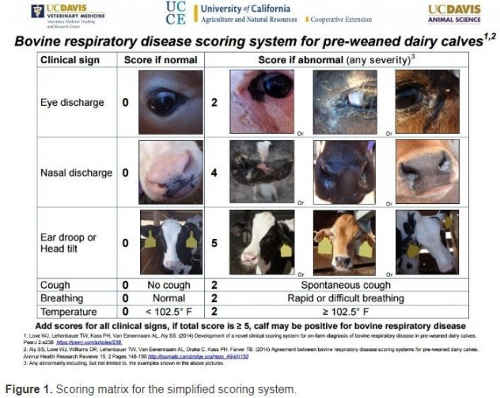By Dan Severson
Winter is approaching, and respiratory disease remains one of the leading causes of illness and death in preweaned dairy calves. ( University of California-Davis )
Respiratory disease is the cause of 22.5% of deaths in unweaned heifers and 46.5% in weaned heifers, according to the USDA National Animal Health Monitoring System (NAHMS). For the survivors, a respiratory event early in a heifer’s life could result in lifelong lung damage that curtails future health and profitability. Replacement heifers that experience early life pneumonia are more likely to have impaired growth; delayed age at first calving; increased probability of having a difficult delivery at first calving; and premature culling, when compared to their healthier herdmates.
University of California-Davis researcher Amy Young said early detection and treatment of sick animals is important regardless of cause. “Often there are multiple causes of respiratory disease, such as a combination of viral and bacterial infections, along with various management and environmental stressors,” said Young.
Among a group of animals, individuals may be observed with varying severity and stage of disease. Diagnostic tests can be expensive, so caretakers should be trained to consistently assess an animal’s health status. To do so, UC-Davis has developed a simple BRD scoring systems as a way to standardize diagnosis across a large number of animals.
The UC-Davis scoring system assesses six clinical signs. When present, a specific number of points are assigned for each sign. A total score of 5 or higher classifies an individual as a BRD case.
- Cough = 2 points
- Eye discharge = 2 points
- Fever (> 39.2oC) = 2 points
- Abnormal respiration = 2 points
- Nasal discharge = 4 points
- Ear droop or head tilt = 5 points
“One of the advantages of this system is that a rectal temperature is not needed for every calf,” said Young. “Rectal temperature only is needed if the total score for the visible signs is 4. A fever could then tip the score over the cutoff of 5.”

Researchers have compared the UC-Davis scoring system to a similar – but more elaborate – system developed at the University of Wisconsin. Validation of the simplified scoring system was performed by scoring 500 hutch-raised calves in parallel on both the UC-Davis system and the Wisconsin system. The Wisconsin system uses five clinical signs scored by level of severity. The UC-Davis system scored slightly higher in sensitivity (72.3% vs. 70.8%), while the Wisconsin system was slightly more specific (93.1% vs. 89.9%).
“At the end of the day, the best scoring system for a particular farm is the one that will actually be used on a regular basis to determine which animals are sick,” said Young. “A simplified system that is easy to implement allows for the identification of sick animals more efficiently, thereby allowing them to be treated in a timelier manner. This has positive implications not only for the individual calf, but overall for animal welfare improvement.”
Source: udel.edu